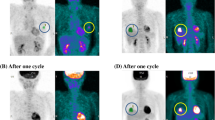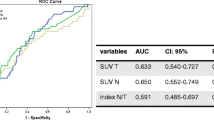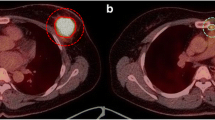Abstract
Purpose
The aim of the study was to investigate the influence of dual time point 2-deoxy-2-[18F]fluoro-D-glucose ([18F]FDG) positron emission tomography/x-ray computed tomography (PET/CT) on the standard uptake value (SUV) and volume-based metabolic variables of breast lesions and their relation with biological characteristics and molecular phenotypes.
Procedures
Retrospective analysis including 67 patients with locally advanced breast cancer (LABC). All patients underwent a dual time point [18F]FDG PET/CT, 1 h (PET-1) and 3 h (PET-2) after [18F]FDG administration. Tumors were segmented following a three-dimensional methodology. Semiquantitative metabolic variables (SUVmax, SUVmean, and SUVpeak) and volume-based variables (metabolic tumor volume, MTV, and total lesion glycolysis, TLG) were obtained. Biologic prognostic parameters, such as the hormone receptors status, p53, HER2 expression, proliferation rate (Ki-67), and grading were obtained. Molecular phenotypes and risk-classification [low: luminal A, intermediate: luminal B HER2 (−) or luminal B HER2 (+), and high: HER2 pure or triple negative] were established. Relations between clinical and biological variables with the metabolic parameters were studied. The relevance of each metabolic variable in the prediction of phenotype risk was assessed using a multivariate analysis.
Results
SUV-based variables and TLG obtained in the PET-1 and PET-2 showed high and significant correlations between them. MTV and SUV variables (SUVmax, SUVmean, and SUVpeak) where only marginally correlated. Significant differences were found between mean SUV variables and TLG obtained in PET-1 and PET-2. High and significant associations were found between metabolic variables obtained in PET-1 and their homonymous in PET-2. Based on that, only relations of PET-1 variables with biological tumor characteristics were explored. SUV variables showed associations with hormone receptors status (p < 0.001 and p = 0.001 for estrogen and progesterone receptor, respectively) and risk-classification according to phenotype (SUVmax, p = 0.003; SUVmean, p = 0.004; SUVpeak, p = 0.003). As to volume-based variables, only TLG showed association with hormone receptors status (estrogen, p < 0.001; progesterone, p = 0.031), risk-classification (p = 0.007), and grade (p = 0.036). Hormone receptor negative tumors, high-grade tumors, and high-risk phenotypes showed higher TLG values. No association was found between the metabolic variables and Ki-67, HER2, or p53 expression.
Conclusion
Statistical differences were found between mean SUV-based variables and TLG obtained in the dual time point PET/CT. Most of PET-derived parameters showed high association with molecular factors of breast cancer. However, dual time point PET/CT did not offer any added value to the single PET acquisition with respect to the relations with biological variables, based on PET-1 SUV, and volume-based variables were predictors of those obtained in PET-2.


Similar content being viewed by others
References
García Vicente AM, Soriano Castrejón A, León Martín A et al (2013) Molecular subtypes of breast cancer: metabolic correlation with 18F-FDG PET/CT. Eur J Nucl Med Molec Imag 40:1304–1311
Bolouri MS, Elias SG, Wisner DJ et al (2013) Triple-negative and non-triple-negative invasive breast cancer: association between MR and fluorine-18 fluorodeoxyglucose PET imaging. Radiology 269:354–361
Koo HR, Park JS, Kang KW et al (2014) 18F-FDG uptake in breast cancer correlates with immunohistochemically defined subtypes. Eur Radiol 24:610–618
Zytoon AA, Murakami K, El-Kholy M-R et al (2008) Dual time point FDG-PET/CT imaging. Potential tool for diagnosis of breast cancer. Clin Radiol 63:1213–1227
Mavi A, Urhan M, Yu JQ et al (2006) Dual time point 18F-FDG PET imaging detects breast cancer with high sensitivity and correlates well with histologic subtypes. J Nucl Med 47:1440–1446
Basu S, Chen W, Tchou J et al (2008) Comparison of triple-negative and estrogen receptorpositive/ progesterone receptor positive/HER2-negative breast carcinoma using quantitative fluorine-18 fluorodeoxyglucose/positron emission tomography imaging parameters. A potentially useful method for disease characterization. Cancer 112:995–1000
Shimoda W, Hayashi M, Murakami K et al (2007) The relationship between FDG uptake in PET scans and biological behavior in breast cancer. Breast Cancer 14:260–268
García Vicente AM, Soriano Castrejón A, Relea Calatayud F et al (2012) 18F-FDG retention index and biologic prognostic parameters in breast cancer. Clin Nucl Med 37:460–466
García Vicente AM, Cruz Mora MA, León Martín AA et al (2014) Glycolitic activity with 18F-FDG PET/CT predicts final neoadjuvant chemotherapy response in breast cancer. Tumour Biol 35:11613–11620
Goldhirsch A, Wood WC, Coates AS et al (2011) Strategies for subtypes—dealing with the diversity of breast cancer: highlights of the St. Gallen international expert consensus on the primary therapy of early breast cancer 2011. Ann Oncol 22:1736–1747
Lu P, Yu L, Li Y et al (2010) A correlation study between maximum standardized uptake values and pathology and clinical staging in non-small cell lung cancer. Nucl Med Commun 31:646–651
Koksal D, Demiragn F, Bayiz H et al (2013) The correlation of SUVmax with pathological characteristics of primary tumor and the value of tumor/ lymph node SUVmax ratio for predicting metastasis to lymph nodes in resected NSCLC patients. J Cardiothorac Surg 8:63
Kajary K, Tokes T, Dank M et al (2015) Correlation of the value of 18F-FDG uptake, described by SUVmax, SUVavg, metabolic tumour volume and total lesion glycolysis, to clinicopathological prognostic factors and biological subtypes in breast cancer. Nucl Med Commun 36:28–37
Kaida H, Toh U, Hayakawa M et al (2013) The relationship between 18F-FDG metabolic volumetric parameters and clinicopathological factors of breast cancer. Nucl Med Commun 34:562–570
García Vicente AM, Soriano Castrejón A, Pruneda González RE et al (2016) Basal-18F-FDG PET/CT as a predictive biomarker of tumor response for neoadjuvant therapy in breast cancer. Rev Esp Med Nucl Imagen Mol 35:81-87
Kahraman D, Scheffler M, Zander T et al (2011) Quantitative analysis of response to treatment with erlotinib in advanced non-small cell lung cancer using 18F -FDG and 3′-deoxy-3′-18F-fluorothymidine PET. J Nucl Med 52:1871–1877
Lee SM, Bae SK, Kim TH et al (2014) Value of 18F -FDG PET/CT for early prediction of pathologic response (by residual cancer burden criteria) of locally advanced breast cancer to neoadjuvant chemotherapy. Clin Nucl Med 39:882–886
Groheux D, Giacchetti S, Moretti J-L et al (2011) Correlation of high 18F-FDG uptake to clinical, pathological and biological prognostic factors in breast cancer. Eur J Nucl Med Mol Imaging 38:426–435
Deng SM, Zhang W, Zhang B et al (2015) Correlation between the uptake of 18F-fluorodeoxyglucose (18F-FDG) and the expression of proliferation-associated antigen Ki-67 in cancer patients: a meta-analysis. PLoS One 10:e0129028
Author information
Authors and Affiliations
Corresponding author
Ethics declarations
The study included seven hospitals and was approved by the respective institutional review boards. Written informed consent was obtained from all patients.
Conflict of Interest
The authors declare that they have no conflict of interest.
Disclaimer
All the authors have participated in the writing and revision of this article and take public responsibility for its content.
The present publication is approved by all authors and by the responsible authorities where the work was carried out.
All the authors confirm the fact that the article is not under consideration for publication elsewhere.
Rights and permissions
About this article
Cite this article
Garcia-Vicente, A.M., Pérez-Beteta, J., Pérez-García, V.M. et al. Metabolic Tumor Burden Assessed by Dual Time Point [18F]FDG PET/CT in Locally Advanced Breast Cancer: Relation with Tumor Biology. Mol Imaging Biol 19, 636–644 (2017). https://doi.org/10.1007/s11307-016-1034-x
Published:
Issue Date:
DOI: https://doi.org/10.1007/s11307-016-1034-x




